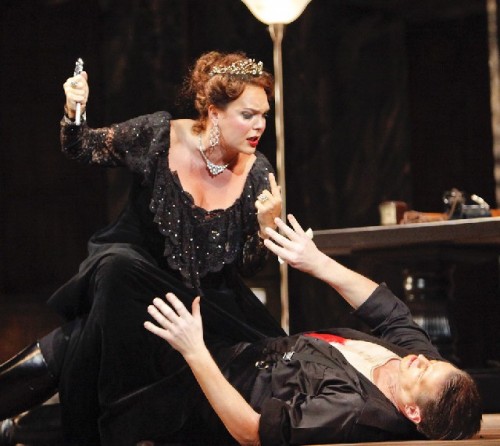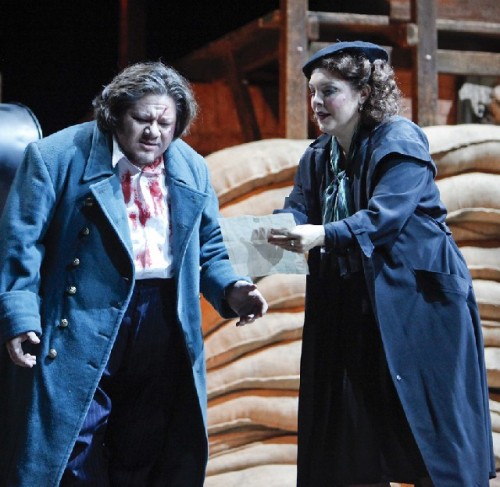Tosca at Boston Lyric Opera
Art and Politics
By: David Bonetti - Nov 07, 2010
Tosca
By Giacomo Puccini
Boston Lyric Opera
Shubert Theatre
Additional performances: November 10, 12,14 (matinee), 16
617-542-6772 for tickets
Bostonians of a political mind – and who in Boston is not? – had the opportunity this fall to see two of the most forthrightly political operas in the repertoire, “Fidelio” and “Tosca,” in quick succession. Beethoven wrote “Fidelio” in the first years of the 19th century, within living memory of the revolutions that overthrew the old regimes and spurred the reactionary movements that always spring up in the aftermath of progressive change. In “Tosca,” which premiered in 1900, Puccini looked back at that heroic historical period from a century’s perspective. In both operas, a tyrant is overthrown, although the romantic couples struggling against oppression at the center of each drama meet different fates. Beethoven presents a happy ending, his two lovers reunited; Puccini kills off his lovebirds, showing pessimistically that evil outlives even the tyrant’s death.
Opera Boston, unfortunately, in an overall fuzzy concept, downplayed the political aspects of “Fidelio.” Boston Lyric Opera, by contrast, emphasized the politics – and the contemporary relevance – of “Tosca” by moving its setting from the Napoleonic era to that of Mussolini’s Italy.
(Quick plot summary: Floria Tosca is a famous and glamorous opera star. Her lover is the painter Mario Cavaradossi, who has revolutionary sympathies. Angelotti, a political prisoner, has just escaped from prison and made his way to the church where Mario is painting a picture. Mario aids in his escape, which gives the Baron Scarpia, Rome’s evil police chief, a reason to chase them both down and in the process seduce Tosca, a double dose of victory. In short order, he captures Cavaradossi, tortures him and gets Tosca to divulge Angelotti’s hiding place. Tosca agrees to Scarpia’s terms, but before he can fulfill them and after he has written her a safe-pass out of Rome, she stabs him to death. Thinking that the execution is a pretense, Tosca is distraught when Mario is actually killed and as the police rush to her after learning of Scarpia’s murder, she throws herself off the prison’s parapet. Each of the opera’s acts, which occur within a 24-hour span, is set in a different Roman landmark, making the opera a love-letter of sorts to the eternal city. Act I is in the church of Sant’Andrea della Valle; Act II in the Palazzo Farnese, where Scarpia has his offices; and Act III on the ramparts of the Castel Sant’Angelo.)
Resetting operas in times and places different from their texts is no longer as controversial as it was 30 years ago when it was the calling card of the opera avant-garde. (Remember Peter Sellars’ resetting of “Le Nozze di Figaro” from a Spanish country house to a penthouse in the Trump Tower?) Since then the number of such updated productions have probably amounted to a draw, the successes equaling the failures.
Boston Lyric’s updating, an “adaptation” of a Scottish Opera production, does no harm, the least you can expect from any such change. All the actions are left in their original settings and could plausibly take place in them, even with more modern décor and dress. And in a number of scenes, the explicitly fascist imagery of 1930s Italy leaves a chill that no production set in the Napoleonic era can today, no matter how evil Scarpia is portrayed. It’s the difference between the knee-high leather boot, the leather hat, the long black leather trench coat and the garb of an old regime tyrant. We know what the former costume denotes, we not so sure about the latter. The change in Tosca’s costume’s from a famous opera star’s mid-century Italian chic to a getaway outfit complete with beret that a heroine in an Italian neo-realist movie set in the chaos of post-war Rome might wear is also telling.
In general, the production concept (by Anthony Besch), the sets and costumes (by Peter Rice) and the local stage direction (by David Lefkowich) and lighting design (Paul Heckenmueller) deserve high marks. Although there are a few caveats, the primary one being a red-gowned Tosca unnecessarily appearing at the end of Act I to hover over Scarpia.
“Tosca” has been famously called a shabby little thriller. And it’s true that it’s not as high-minded as many of its predecessors, among them Beethoven’s “Fidelio.” But – tell the truth – which opera would you rather see? For its virtues – rich orchestration, ravishing arias and ensembles – “Fidelio” is dead in the water theatrically. There’s a reason Beethoven never wrote another opera. He realized it was not his strength. Puccini, on the other hand, was a man of the theater and he wrote virtually nothing but opera. A shabby little thriller, yes, but a thriller, first and foremost, and you sit on the edge of your seat (metaphorically, of course) even if you’ve seen it a dozen times. Like all good thrillers, there’s not an extraneous line – just the inexorable drive to the plot’s resolution.
The test of a good “Tosca” is whether it thrills or not, and this one does. (Of course even a lousy production of the opera can’t help but thrill. Puccini has written a fail-safe work: The thrills are built-in.) In addition to the production strengths, the principal cast members fully inhabit their characters. The playful scene between Tosca (Jill Gardner) and Mario (Diego Torres) in Act I suggests a previous physical familiarity, and her jealousy is more than credibly projected, even as you know that she will forgive Mario almost anything. And Scarpia (a Scott Brown good-looking Bradley Garvin) is menacing from his first entrance, his storm-trooper outfit the ornament of his sexy persona. (Read Susan Sontag’s “Fascinating Fascism” if you don’t understand the allure.) The scene between Tosca and Scarpia as he maps out her seduction while her lover is being tortured off-stage is physically exacting and emotionally gripping: the prelude to a negotiated rape, but, boy, does she have a surprise for him. Her stabbing is brutal and drawn out. First she drops the hidden knife, then, recovering, grabs a pair of scissors off his desk and stabs him again and again and again, crying “muori” – die!
Unfortunately, the singing did not come close to equaling the acting. All principals are solid, but none offer the thrills of great Italian singing. Torre lacks the Italian “ping” that made singers like Luciano Pavarotti (and today’s Juan Diego Florez) rich and famous. His cry of “Vittoria” when the news of a Napoleonic victory interrupts his torture did not ring. The memory of Franco Corelli on tour here a quarter of a century ago with the Met at Hynes Auditorium still resounds in my ears. (Not to mention Pavorotti singing under the same auspices with Magda Olivero, but you can’t compare anything to that night – it was a once-in-a-lifetime experience.) And his delivery of “E lucevan le stelle,” (“And the stars shone”) in which he reflects, before his execution, on his love of his soon-to-be-extinguished life, lacked the melting lyricism that makes it a highlight of the tenor repertoire.
Gardner was even less convincing vocally. Although her bottom and middle notes were secure, her upper voice was tight. Her “Vissi d’arte, vissi d’amore (“I lived for art, I lived for love”) – the great aria in the opera, one of the greatest arias in all opera – went over like the proverbial lead balloon. Instead of a natural outpouring of a woman facing a rape by a hated oppressor, it was all too effortful. Her singing caused a sympathetic but uncomfortable straining in the listener that accompanies a singer stretching for high notes.
Garvin came off best vocally. His entrance in Act I was chilling visually and dramatically and his aria that closes the act, yellow light playing over his features as he pours out the sacrilegious statement, “Tosca, you make me forget God,” was also vocally chilling. In Act II, his quick switch from fascist torturer to suave seducer worked as well vocally as it did dramatically. And his Iago-like aria explaining his brutal philosophy – “There is more to savor to a conquest by violence than to the most-honeyed consent” – was put across effectively.
The minor roles were sung similarly: correctly but without distinction. (The Sacristan, T. Stephen Smith, was better than that, playing down the slapstick, but still comic.)
Andrew Bisantz conducted with authority from the first fortissimos intoning the theme representing Scarpia, suggesting that the police chief might be the key character of the work, to the Act III lyricism of Cavardossi’s reflections on his coming death. I had heard complaints about the Shubert Theatre, but the acoustics seemed fine to me from my orchestra seat. There was no gap between orchestra and sounds produced on the stage. The sound texture was whole.





